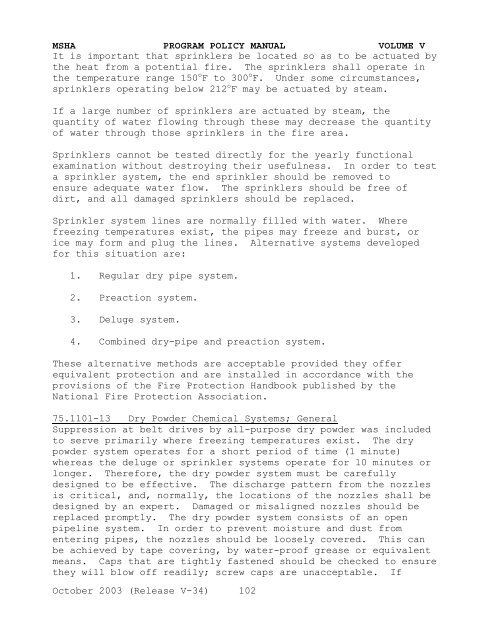Program Policy Manual - VOLUME V - Mine Safety and Health ...
Program Policy Manual - VOLUME V - Mine Safety and Health ...
Program Policy Manual - VOLUME V - Mine Safety and Health ...
Create successful ePaper yourself
Turn your PDF publications into a flip-book with our unique Google optimized e-Paper software.
MSHA PROGRAM POLICY MANUAL <strong>VOLUME</strong> V<br />
It is important that sprinklers be located so as to be actuated by<br />
the heat from a potential fire. The sprinklers shall operate in<br />
the temperature range 150 o F to 300 o F. Under some circumstances,<br />
sprinklers operating below 212 o F may be actuated by steam.<br />
If a large number of sprinklers are actuated by steam, the<br />
quantity of water flowing through these may decrease the quantity<br />
of water through those sprinklers in the fire area.<br />
Sprinklers cannot be tested directly for the yearly functional<br />
examination without destroying their usefulness. In order to test<br />
a sprinkler system, the end sprinkler should be removed to<br />
ensure adequate water flow. The sprinklers should be free of<br />
dirt, <strong>and</strong> all damaged sprinklers should be replaced.<br />
Sprinkler system lines are normally filled with water. Where<br />
freezing temperatures exist, the pipes may freeze <strong>and</strong> burst, or<br />
ice may form <strong>and</strong> plug the lines. Alternative systems developed<br />
for this situation are:<br />
1. Regular dry pipe system.<br />
2. Preaction system.<br />
3. Deluge system.<br />
4. Combined dry-pipe <strong>and</strong> preaction system.<br />
These alternative methods are acceptable provided they offer<br />
equivalent protection <strong>and</strong> are installed in accordance with the<br />
provisions of the Fire Protection H<strong>and</strong>book published by the<br />
National Fire Protection Association.<br />
75.1101-13 Dry Powder Chemical Systems; General<br />
Suppression at belt drives by all-purpose dry powder was included<br />
to serve primarily where freezing temperatures exist. The dry<br />
powder system operates for a short period of time (1 minute)<br />
whereas the deluge or sprinkler systems operate for 10 minutes or<br />
longer. Therefore, the dry powder system must be carefully<br />
designed to be effective. The discharge pattern from the nozzles<br />
is critical, <strong>and</strong>, normally, the locations of the nozzles shall be<br />
designed by an expert. Damaged or misaligned nozzles should be<br />
replaced promptly. The dry powder system consists of an open<br />
pipeline system. In order to prevent moisture <strong>and</strong> dust from<br />
entering pipes, the nozzles should be loosely covered. This can<br />
be achieved by tape covering, by water-proof grease or equivalent<br />
means. Caps that are tightly fastened should be checked to ensure<br />
they will blow off readily; screw caps are unacceptable. If<br />
October 2003 (Release V-34) 102
















